| Aztlan | ||||||||||||||||||||||||||||||||||||||||||||||||||
|---|---|---|---|---|---|---|---|---|---|---|---|---|---|---|---|---|---|---|---|---|---|---|---|---|---|---|---|---|---|---|---|---|---|---|---|---|---|---|---|---|---|---|---|---|---|---|---|---|---|---|
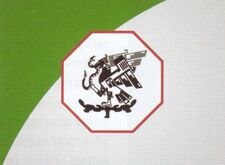
| ||||||||||||||||||||||||||||||||||||||||||||||||||
| ||||||||||||||||||||||||||||||||||||||||||||||||||
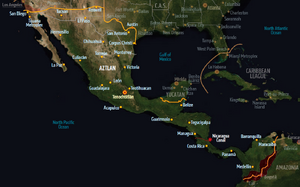
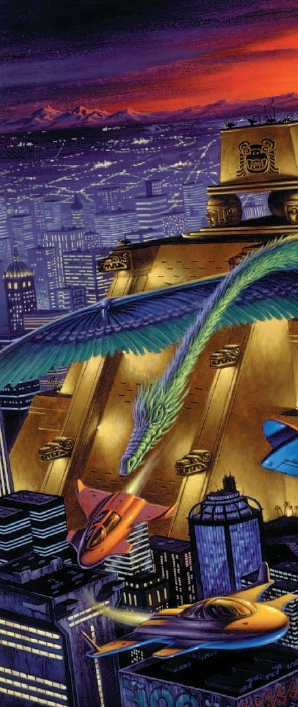
Tenochtitlan
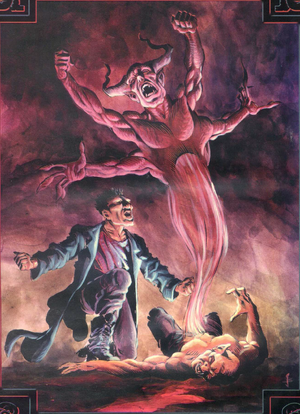
Blood Mage
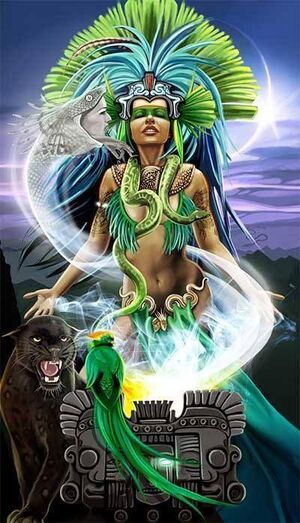
High Priestess
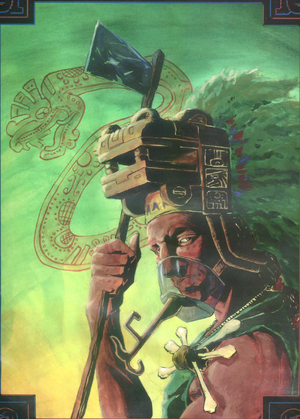
Shaman of Quetzaquatl

Aztlan Decker
Aztlan is a country covering all of Central America, between Rio Bravo and Nueces River and the Andes. It possess land borders with CAS, Pueblo and Amazonia. The Panama Canal Zone is under the control of the Corporate Court
History[]
- 2007 - The ORO Corporation is formed from the Ortega, Ramos, and Oriz cartels. It will eventually become Aztechnology.[1]
- 2010 - A large fire wipes out a large portion of Tenochtitlán.[2]
- 2012 - The ORO Corporation joins the Inter-Corporate Council, shortly after its formation.[3]
- 2013 - Keruba and ORO engage in a corporate war, which ends in a stalemate when they both expend their resources.[3]
- 2015 - May 15, Aztlan uses the first Matrix-based electoral system for direct elections. The Azatlán party assumes power.[4]
- 2017 - Aztlan joins the NAN.[5]
- 2022 - The ORO Corporation renames itself into Aztechnology Corporation, and proceeds to insinuate itself into every aspect of Aztlan's government.[6]
- 2027 - Aztlan revokes the Roman Catholic Church's tax-free status. In the following years, a detailed audit leveled charges of tax evasion and outright fraud against important church figures, including the Most Reverend Jésus de la Torrez, Tenochtitlán's archbishop.[7]
- 2034 - Aztlan secedes from the Sovereign Tribal Council and the NAN.[8]
- 2035 - Shortly after the secession of the CAS, Aztlan moves northward to claim some of Texas, including San Antonio and parts of Austin.[9]
- 2041 - An executive order from the President's office officially rescinds the Roman Catholic Church's right to function in Aztlan. The church becomes an underground illegal organization.[7]
- 2044 - The Aztlan government nationalized all holdings belonging to corporations save for Aztechnology.
- 2045 to 2047 - The nations of Guatemala, Belize, Honduras, El Salvador, and Nicaragua were accepted (some say annexed) as member states of Aztlan.[10]
- 2048 - Panama petitions for membership in Aztlan and is accepted.[10]
- 2048 - The Corporate Court retaliates with Operation RECIPROCITY against Aztechnology holdings. This is followed by the Veracruz Settlement.[11]
- 2048 - Aztlan cedes control of the Panama Canal Zone to the Corporate Court. It becomes known as the "Pan-Corporate Zone".[12]
- 2049 - Amazonia and Aztlan annex much of Venezuela and Colombia. Both nations make allegations that the other nation was being the aggressor and the nations were annexed for their own protection.
- 2056 - Aztlan hosts the 2056 World Cup International football (soccer) competition.[13]
- 2062 - Yucatan insurgency begins.
- 2064 - End of Yucatan insurgency. Peace treaty with rebels, giving Yucatan autonomy.
- 2072 - Amazonian War begins.
- 2074 - The Amazonian War ends with territorial gains made by Aztlan and its reputation in the world strengthened. In the same year, Aztlan seizes all of Denver south of 6th Avenue under the cover of a blizzard during the Siege of Denver crisis.
Politics[]
Political Parties[]
- Azatlán Party - The dominant political party, the people who control everything (Aztechnology-backed)
- Partido de Acción Nacional (PAN) - Closely linked with the Catholic Church
- Democrático Nacional (FDN) - Predominantly leftist
- Partido Revolucionario Institucional (PRI) - The party dominant before the VITAS plague
Insurgencies[]
La Venta is a rebel ground fighting the Aztlan government. They are possibly based in Denver or Austin.[14]
Foreign Relations[]
- Amazonia, CAS, Pueblo - outright hostile, with frequent border clashes, especially with the two former.
- Denver - The first act of the city's new ruler, the Great Dragon Ghostwalker, on 27 January 2062, was to retire Aztlan the authority it had over a sector of a city. Which was reversed on 31 October 2074 during the Siege of Denver when Aztechnology's forces occupies all of Denver south of 6th Avenue.
Military Assets[]
Aztlan has access to 200,000 men and women under arms;
National Army[]
The official armed forces of Aztlan, the National Army has 50,000 men and women under arms.[20] It is a military designed to defend territory not project force.[21] The ground forces are mechanized infantry supported by heavy armor. They control the tube artillery (which uses laser-guided projectiles), the main battle tanks, and tactical surface-to-surface missiles. Copying the Soviets of old, they have specially equipped and trained "Operational Maneuver Groups".[22][1]
Aztlaner naval forces consist of destroyers, frigates, patrol boats, and fast-attack submarines. It lacks the aircraft carriers and strategic missile submarines of the great powers.[22] The air force is equipped with a moderate number of reliable aircraft, none of them state-of-the-art. Short-range interceptors and ground attack aircraft, no theater or strategic bombers.[21]
Things appear to be changing as Aztlan is starting to develop power projection abilities and state-of-the-art weapons for its armed forces. In the recent battle against Sirrurg in 2074 AD, in which Aztlan took down the dragon, cutting-edge high-performance and sophisticated fighter aircraft (Bloodwings) were seen engaging the dragon. The navy had built and deployed by that time Aztlan's first nuclear-powered aircraft carrier (Huey Tlatoani).[23][24]
Corporate Army[]
Aztechnology itself has a freestanding corporate army with 150,000 men and women under arms. Though deployed to defend corporate assets and on corporate missions, elements of the corporate army have been deployed right alongside the National Army using the same uniforms and often the same equipment making it nearly impossible to differentiate which units are regular or corporate.[20]
The State of Aztlan[]
Geography[]
Aztlan borders the Confederation of American States, the Pueblo Corporate Council, and the California Free State to the north. The border runs from just north of San Diego eastward, north of Tucson and Odessa, and passes directly through to the city of Austin before looping southward. It passes 75 km east of San Antonio, TX, before striking the Gulf coast between Brownsville, CAS and Matamoros, Aztlan.[25]
Aztlan also contains the Central American countries formerly known as Guatemala, Belize, Honduras, El Salvador, Nicaragua, and Panama (with the exception of the Panama Canal Zone, which is owned by the Corporate Court). The border against the nation of Amazonia to the south sweeps down from the southern tip of Lake Maracaibo (once Venezuela), runs south of Bucaramanga (Colombia), and passes dozens of km south of Bogotá. At that point, the border moves west, passing south of Cali to strike the Pacific Coast. The border is such that Aztlan occupies a small portion of Venezuela and about half of what used to be Colombia (including Cartagena, Medellin).[25][26]
Austin is disputed territory, and is divided between Aztlan and the CAS.[25]
Member States[]
31 states (estados, singular - estado) and 1 federal district* (distrito federal);
- Aguascalientes
- Baja California
- Baja California Sur
- Belize
- Campeche
- Chiapas
- Chihuahua
- Coahuila de Zaragoza
- Colima, Distrito Federal
- Costa Rica
- Durango
- El Salvador
- Guanajuato
- Guatemala
- Guerrero
- Hidalgo
- Honduras
- Jalisco
- Mexico
- Michoacan de Ocampo
- Morelos
- Nayarit
- Nuevo León
- Oaxaca
- Occupied Colombia
- Occupied Texas
- Panama
- Puebla
- Querétaro de Arteaga
- Quintana Roo
- San Diego
- San Luis Potosí
- Sinaloa
- Sonora
- Tabasco
- Tamaulipas
- Tlaxcala
- Tucson
- Veracruz-Llave
- Yucatán
- Zacatecas
Cities[]
- Tenochtitlan
- San Diego-Tijuana
- Tucson
- Austin, Occupied Texas
- San Antonio, Occupied Texas
- Monterrey
- Torreón
- Guadalajara
- Mazatlan
- Mérida, Yukatan
- Puebla
- Veracruz
- Guatemala
- San Salvador
- Tegucigalpa
- Managua
- San José
- Denver(southern part)
Resources[]
During Halley's Comet visit, naturally occurring orichalcum was discovered.[27]
Economy[]
While Aztlan has largely made the transition from a primary resource-based nation to a tertiary, information-based economy, several areas in the country lag behind. Some segments of the poor rural population still survive on subsistence farming. Agriculture (with a major contribution from Aquaculture) plays a major role in Aztlan's economy, engaging roughly 27 percent of the population. Aztlan is entirely self-sufficient when it comes to food. (azt.140) Major exports include food products, natural gas, coffee, zinc, textiles, and various technological products. Major imports include steel, titanium, beryllium, and other metals, chemicals, and industrial and agricultural machinery.[28]
The Aztlan peso rate of exchange is around 500 pesos for 1 nuyen. (azt. 139) However, this rate is achieved by an aggressive monetary policy based on high-volume arbitrage and a two-class monetary system. Every amount of pesos is constituted of peso norma or peso libre. Only peso libre can be exchanged for another currency. Coins and bills exists for peso normal, peso libre is purely electronic. It is thus very difficult to assess Aztlan economic variables.
The Prime Megacorporation Aztechnology is based in Aztlan. Although Aztechnology is a permanent member of the Corporate Court, Aztlan has not signed the Business Recognition Accords.
Shibata has the contract to run the Aztechnology launch center near La Paz in Baja California.[29]
Cultural Groups[]
Metahumans[]
Unlike in the UCAS where people take notice first of what your metaype is and then your skin color, in Aztlan what carries the greatest weight is your cultural group. Are you a peninsular (an Azzie who descends from the Spanish), a mestizo, or an Amerindian. What metatype you are is of lesser importance. For example, a troll peninsular is far higher on the social scale compared to a human or elf mestizo. Within the three castes, there is the usual metatype hierarchy.[30]
Sapients[]
In Aztlan, the percentage of the population which is non-metahuman sentient is over twice as high as the global average. Which includes free spirits, dracoforms, and shapeshifters. Within Aztlan, the majority of dracoforms are of the feathered serpent type. They grant full citizenship to free spirits, unlike most countries and banishing a free-spirit citizen of Aztlan is considered to be an act of homicide by the law and treated as such.[30]
Infected[]
For the infected, Aztlan is a refuge. Aztlan doesn't welcome them with open arms but since they treat the Infected better than others and blood is big in their state religion, they're cheap to employ. The nahuitil and blood mages of Aztlan see vampires as blessed and greatly favor those vampires who serve Aztechnology. The Infected who have combat advantages and abilities make really good money working for Aztechnology. Tamanous is recognized as a legitimate business in Aztlan, providing the Infected with what they need. By law, Tamanous cannot have anyone murdered or kidnapped (or buy from those who have done so), the food they provide comes from medical waste, donations, and corpses.[31][32]
Socio-Economic Classes[]
Corporate Staff[]
The corporates live in corporate complexes known as castillos (castle). Nearly everything a person may want or need is inside the castillos; medical centers, restaurants, theaters (live and trideo or simensense), daycare centers, bars, fitness clubs, and "comfort stations". Residents pay using their thumbprint on a scanner which posts the charge to their residential account and most of the businesses won't take other forms of payment.
Within the castillos and between them there is a rigid hierarchy as to in what castillo you can live and where within a castillo, and the type of facilities you can use and businesses you can spend your money at. Approximately 75% of them telecommute, who are on call 24 hours a day. The rich and powerful among the corporate suits usually have penthouses in the castillos and mansions outside of the city. Where they live as if landed gentry in those walled estates.[33]
Burakumin[]
Unaffiliated workers (aka, burakumin) live in "council complexes" which are a sort of co-op, run and partly subsidized by the state. They are efficient and clean, with most of the facilities the residents need but greatly downgraded from what the castillos have. Therefore no fancy restaurants, but commissaries that are basically cafeterias. Payment is still done via thumbprint. Most of the burakumin physically commute to work, therefore are stuck in gridlock for hours during the rush hour period.[34]
Peasants[]
Rural people make up 21% of the population. Most of them are peasants and grow the food that feeds the cities. Among the peasants, most of them work for the corporations which run the agricultural zones of Aztlan. The standard of living, education level, and per capita is low in those areas. Housing is subsidized by the corporations. Most of these peasants are mestizos.[35]
Subsistence Farmers[]
The rest are subsistence farmers, and most of those are Amerindians. It's as if it's still the 18th century for these farmers, living in abject squalor and barely eking out a living. Normally they live in very tight-knit groups which distrust outsiders. Most of them are uneducated and illiterate. They follow cultural traditions which descend from before the Spaniards and speak their own languages, and some of them can't understand Spanish.[36]
Shadowrunners[]
The Shadowrunner scene in Aztlan is divided into two categories, the Mexicans and everybody else. The locals don't do business with foreigners, use their own fixers, keep their own counsel, and do their own business. All business is based on personal relationships and they could care less about your reputation on the street or the bragsheet you have. If you are unknown to them, they don't want to get to know you, at least when it comes to business.
It's nearly impossible to earn the trust of Mexican shadowrunners, but if you do then you're in. You are treated as if you are a long-lost cousin and will be trusted with their lives, until you betray them once. After which they will hunt you down and kill you. Honor is extremely important to them, and if you do one thing that is dishonorable in their eyes, you have to start all over with them. When it comes to business, most of them do it based on what helps Aztlan.
Imports and Mercenaries, are the rest. The import market functions just as it would in Seattle. With "import" fixers contracting the jobs out based on reputations and bragsheets. Aztlan has a large shadow community with Techochtitlan having approximately 500 "A-list" players and other major cities having significant contingents. The import community is a lot smaller. The city of San Diego (which is of comparable size to Seattle) has an import community of under 100 (of which A-list players are 50 or less).[36]
References[]
This page forked from Wordman's The Sixth World: A geographical index to the world of Shadowrun
- ↑ Aztlan p.52
- ↑ Aztlan p.161
- ↑ 3.0 3.1 Aztlan p.53
- ↑ Aztlan p.37
- ↑ Aztlan p.38
- ↑ Aztlan p.54
- ↑ 7.0 7.1 Aztlan p.94
- ↑ Aztlan p.39
- ↑ Aztlan p.40
- ↑ 10.0 10.1 Aztlan p.41
- ↑ Aztlan p.47
- ↑ Aztlan p.109
- ↑ Aztlan p.166
- ↑ Underworld Sourcebook p.87
- ↑ Target: UCAS p.22
- ↑ New Seattle p.81
- ↑ Year of the Comet p.130
- ↑ Germany Sourcebook p.42
- ↑ Tir Tairngire p.47
- ↑ 20.0 20.1 Aztlan p.76
- ↑ 21.0 21.1 Aztlan p.78
- ↑ 22.0 22.1 Aztlan p.77
- ↑ Conspiracy Theories p.48-49
- ↑ Storm Front p.24-25
- ↑ 25.0 25.1 25.2 Aztlan p.106
- ↑ Storm Front p.32-33
- ↑ Year of the Comet p.85
- ↑ Aztlan p.141
- ↑ Year of the Comet p.18
- ↑ 30.0 30.1 Aztlan p.112
- ↑ Dark Terrors p.135-138
- ↑ Dark Terrors p.138
- ↑ Aztlan p.136
- ↑ Aztlan p.137
- ↑ Aztlan p.137-138
- ↑ 36.0 36.1 Aztlan p.138
Index[]
- Aztlan, 76-79, 106, 141
- Corporate Download
 Sixth World Almanac
Sixth World Almanac- Year of the Comet, pp.115-125, 155-156
- Conspiracy Theories, 48-49
- Storm Front, 24-25, 32-33
